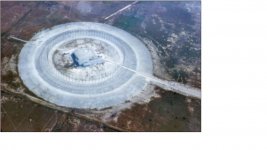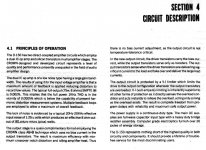is the most recent reference I found to a system that actually lasted until after the USSR collapsed.
Systems under the D.o.D umbrella don’t end their life and stop existing. They are further developed, change their code names and start a new life.
If George can find more there are some very interesting engineering principles learned from this system.
There are more and yes there are very interesting.
But please allow me to divert you –as I think that it would be far more intellectually rewarding - to some early work on engineering principles:
https://ia600304.us.archive.org/5/items/vitruviustenbook00vitruoft/vitruviustenbook00vitruoft.pdf
George
>Edit: For other formats: https://archive.org/details/vitruviustenbook00vitruoft
Last edited:
Systems under the D.o.D umbrella don’t end their life and stop existing. They are further developed, change their code names and start a new life.
George
Yes but folks think you are paranoid if you show interest in some of the secret stuff.
This is a nice older satellite photo of an interesting installation. Note the tall round thing is not a fence. (The short round one probably is the fence.) It is part of an antenna system! The scale indicates the frequency range.
Pavel could probably explain its' purpose.
Attachments
Last edited:
I keep pressing the [ESC] key, but I'm still here.
-RM
I could tell you how to really do that, but I prefer you stick around as your input is interesting.
Wide-Aperture Direction Finding (WADF) Circularly Disposed Antenna Array (CDAA).
NSGA Homestead, Florida - Photos taken during 1970 - from Ken Halliwell (former CTM1)
These enormous antennas arrays contain dozens of monopoles arranged in a circle with diameters ranging from 50m to over 150m. Such systems used a capacitive switching goniometer to electronically select each antenna and produce highly-accurate azimuthal headings with sub-1-degree precision. These arrays were placed throughout the United States and networked extensively to provide accurate headings for any high frequency radio signals detected.
NSGA Homestead, Florida - Photos taken during 1970 - from Ken Halliwell (former CTM1)
No, it was designed in the early 70's at Phillips Research by Matti Otala and Jan Lostroh. There is an AES paper describing it completely. The amp was copied by Electrocompaniet in Norway, and is usually called the 'Otala' amp. It was a revolution in amp design.
Here it is
http://www.linearaudio.nl/linearaudio.nl/images/pdf/otala%20low%20tim%20amp.pdf
Does this chip, if changed to Class-A, fulfill Otala-Lohstroh?
THS3001 | High Speed Amplifier (>=50MHz) | Operational Amplifier (Op Amp) | Description & parametrics
I realise it's not the same as a full-scale amplifier, but I have never heard of this TIM concept in my life and have no idea where to audition it, so a Current-feedback chip in Class-A with perfect transient response might be a good start?
THS3001 | High Speed Amplifier (>=50MHz) | Operational Amplifier (Op Amp) | Description & parametrics
I realise it's not the same as a full-scale amplifier, but I have never heard of this TIM concept in my life and have no idea where to audition it, so a Current-feedback chip in Class-A with perfect transient response might be a good start?
Just about any of the Crown D-Series power-amplifiers (i.e., D-75, D-150, DC-300 stereo amplifiers) from the early 1970's would present most of the problematic sound attributes of TIM; they're all readily available on EBay from about $150-$300, so auditioning the troublesome topology (5-9 gain stages in series, wrapped in massive quantities of NFB) is easily at hand... 
can't find a readable schematic but the service manual does claim a op amp is used for input - that would be a early 1970's op amp
and that the output Q are zero bias Class B
not sure what that means to anyone trying to design a good amp in 2014, having the benefit of Self and Cordell's Books, 4 decades of JAES, WW(while it was still good), Jan's Linear Audio, discussions here that have actual technical content....
and that the output Q are zero bias Class B
not sure what that means to anyone trying to design a good amp in 2014, having the benefit of Self and Cordell's Books, 4 decades of JAES, WW(while it was still good), Jan's Linear Audio, discussions here that have actual technical content....
The Crown D series would be a good candidate for TIM.
I don't suppose "from the early 1970's " matters.
can't find a readable schematic but the service manual does claim a op amp is used for input - that would be a early 1970's op amp
and that the output Q are zero bias Class B
not sure what that means to anyone trying to design a good amp in 2014, having the benefit of Self and Cordell's Books, 4 decades of JAES, WW(while it was still good), Jan's Linear Audio, discussions here that have actual technical content....
LM301 I think.
EDIT - My bad parts list has uA739/49 somewhere in the circuit.
Last edited:
Hmmm. Looks like there is no Miller cap, only 200pF from VAS output to Gnd. VAS seems to have about 8mA bias, which puts the slew rate at about 50V/usec. Not bad for an amp 15 years ahead of Otala 
So whatever it is that makes it sound bad, slew rate certainly aint it!
Jan
So whatever it is that makes it sound bad, slew rate certainly aint it!
Jan
Just about any of the Crown D-Series power-amplifiers (i.e., D-75, D-150, DC-300 stereo amplifiers) from the early 1970's would present most of the problematic sound attributes of TIM; they're all readily available on EBay from about $150-$300, so auditioning the troublesome topology (5-9 gain stages in series, wrapped in massive quantities of NFB) is easily at hand...
70's , so whats the excuse today ......
I don't suppose "from the early 1970's " matters.
Scott,
Let's be fair, Crown has produced a few reasonable "audiophile" power-amplifiers; their Macro Reference got a fairly positive review in Stereophile (Crown Macro Reference power amplifier | Stereophile.com)
No music. This amplifier made no music. Not to say that it wasn't sonically impressive at times, but the music got lost somewhere between input and output.
Sonic spectacle and musical accuracy don't always go hand in hand, but this was a textbook case. It's clear that Crown wanted to change its image with this amplifier, and it did. Gone was the bright, hard quality of earlier years, replaced by a dark, thick, grainy character that obscured all the finer details of the musical performance. No matter which digital processor, preamplifier, or interconnects I used, the quality remained the same: thick, woolly, and opaque, with a brittle, forward midrange. I auditioned all three samples, but the results were the same. Dual-mono operation did nothing to improve the situation; in fact, it sounded somewhat worse.
That's fairly positive?
- Status
- Not open for further replies.
- Home
- Member Areas
- The Lounge
- John Curl's Blowtorch preamplifier part II

